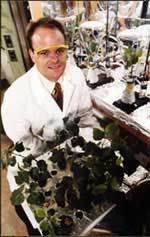A Clean, Green Pollution Solution
Posted by news
Here’s an idea that will grow on you: using trees and other plants to reduce water and ground pollution — and reducing overall cleanup costs.
 |
| Joel Burken |
That’s the goal of environmental engineer Joel Burken, an assistant professor of civil engineering at UMR, who is leading a team of graduate and undergraduate students in this nontraditional research effort.
"Who would have thought that trees could help purify water?" says Burken. But that’s exactly the goal behind a relatively new idea in environmental engineering. Known as "phytoremediation," the method involves using plants to clean up pollutants.
"I hope that phytoremediation will revolutionize the process of remediating contaminated sites," Burken says. "The effort could replace the current methods now being used to cleanse contaminated soil and groundwater."
Some of those current methods of water purification consists of pumping, heating or even baking the ground to extract the pollutants. "All of those measures, especially pumping, are incredibly expensive," Burken says. "In contrast, phytoremediation uses living plants to reduce contaminated soil, sludges and groundwater in a less expensive way."
Phytoremediation has also been expanded to provide safer methods of cleaning metals, crude oil, and landfill leachates, Burken says. Working in conjunction with the University of Connecticut and Ecolotree Inc., an environmental engineering company, Burken plans to cut costs by using poplar trees to remove the pollutants from water tables that may be used for drinking water. One method involves incorporating genetically enhanced microbes with the planting of the trees. This type of "genetic engineering" gives the microbes the ability to break down naturally, Burken says.
University of Connecticut researchers do the actual genetic engineering part of the process, creating the enhanced microbes. Burken carries on the process by inoculating cuttings from the trees. Burken tests the trees to see the impacts of the genetic engineering. The research has proven to be beneficial, Burken says. "In one case, 1,700 poplar trees were planted on a contaminated U.S. Navy site. The efforts resulted in saving the site about $5 million in the clean-up process."
While "there are still many questions left unanswered about exactly why this process works, it seems to work," says Burken. "But we don’t know exactly why. It is just a simple but elegant process that does the job."